Introduction
In this guide, I will provide you with the basics on how to get your tank rolling into the battlefield. You will learn to use the gears, levers, and dashboard all together. I will try to simplify and make comparisons to your day-to-day cars and bicycles so you can understand the whys and hows. Now, I do not claim to be an expert or even an enthusiast on tanks so please forgive wrong terminologies. The whole point is to remove the intimidation factor of being in the driver’s seat for new tankers.
In “The Basics”, I will give you all the background info you need to understand the stick shift, the levers in front of you, and the dash. “Stick Shift Patterns” is a reference you can use to familiarize yourself with the gearbox. The “In Practice” section will give you a rundown or checklist on exactly what to do once you get in the driver position and how all the pieces come together. You can skip to this section if you are already familiar with the basics. The last section, “Tips and References” is self-explanatory.
The Basics
“This is nothing like a car,” is perhaps the first impression you get when sitting down in the driver’s seat of the Firefly. Of course, a car and a tank serve completely different purposes and drive differently, but they might be more similar than you think. Keep in mind that these WWII tanks were made to be straightforward; a simple design keeps training short and costs low.
The essential tools in the cockpit include two levers, two pedals (cut from the picture), a gear selector, and the dash. Though the picture below is of the Firefly, the layout and concepts are similar in the T-34. Learn how to operate and coordinate all of the above together and you’ll be a master in no time. This section will mainly cover background information to understand “how things work” and not necessarily “how to do”. For that, reference “In Practice” and the in-game controls.
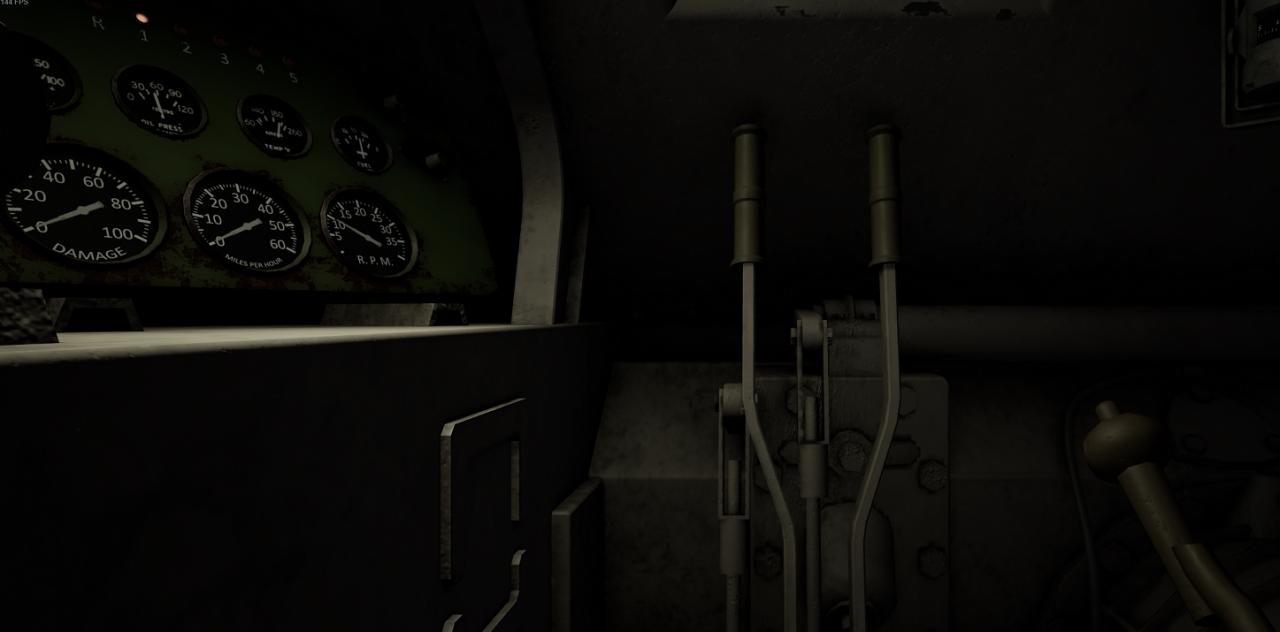
I want you to turn your attention to the gear selector on the right. That’s right, you’ll have to learn how to select the correct gear for your situation if you want to get this tank rolling. If you know how to drive a “stick” in real life, then you can skip this section completely as you know the foundation of how it works.
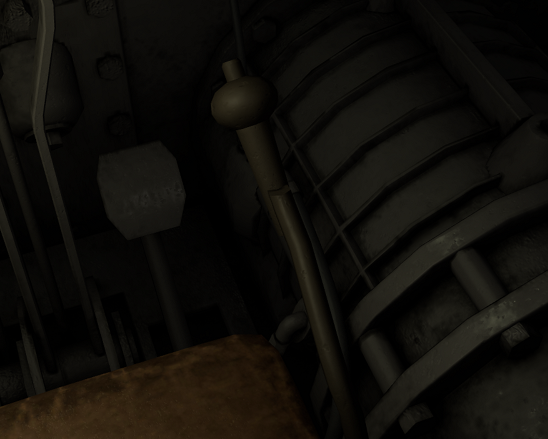
To learn how to drive a manual, you have to let go of the concept of “gas is go and more gas is go faster”. Instead, your accelerator input only tells the engine how fast you want it to spin. The engine, however strong or weak, is only designed to spin in a certain range before it blows up or shuts off. To manage the work on the engine, we use gears. Since the vehicle doesn’t shift automatically, it is the driver’s responsibility to select the right gear for the job.
If you’ve ever used a multi-speed bike, you’re already familiar with this concept. I want you to imagine your legs as the engine. Selecting gears probably came naturally as you know how much work you can handle. You can only physically pedal so fast before you have to coast, and you can only pedal so slow before you’re putting your entire weight on one foot, not moving, and falling over. You’ve probably discovered that the lower gears allow you to climb hills and take off from a start, but the higher gears allow you to pick up speed.
Similarly in a car or tank, use bigger gears when you need more torque or force to get the vehicle moving. As you speed up, the engine will spin faster. To prevent it from blowing up and to go even faster, use smaller gears. When you slow down, whether it be braking, turning, or going up a hill, the engine will spin slower. It might slow to a point where it doesn’t have enough power to get going again. In this case, go back to the bigger gears to get the engine spinning at its optimal range. We’ll cover how to monitor engine speed and more gear selection tips in “The Dashboard” and pictures in the “Gear Stick Pattern” sections.
Note: It is important to note that the clutch plays a huge factor in manual transmission and is the most difficult to operate (in my opinion). However, this game uses an assisted shifting system and the clutch is a no-factor. The only pedal you can use is the accelerator (one on the right).
In a car, we have a steering wheel that points the front two tires in the direction we want to go. So how does a tank with one track on each side turn? Simple, one side spins faster than the other and the speed difference pivots the tank. How do we do this? Turn your attention to the two levers that are front and center.
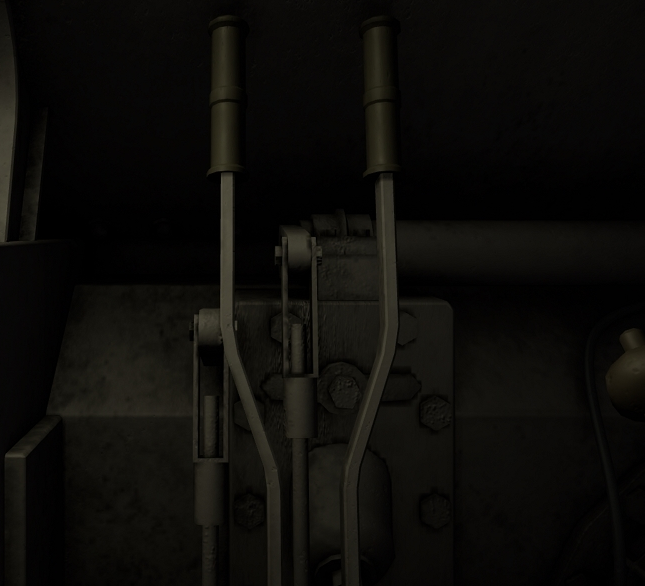
Both tanks in the game have a “Clutch Braking” turning mechanism. To oversimplify, the engine puts power into both tracks. There is a clutch that controls the transfer of power from the engine to the driving sprocket on each side (not to be confused with the clutch that allows you to shift gears). When the levers are not engaged, the clutch is fully engaged on both sides. Pulling on one lever will gradually release the clutch on the corresponding side. This slippage or release from receiving power will slow that side down, allowing for the turn.
Further pulling of the lever engages the brakes on that side. This allows for adjustment of the turning angle. The more the lever is pulled towards you, the harder the brakes, and the tighter the turn. Don’t be surprised if you spin out if you pull the lever too hard!
So keep in mind that with clutch braking, you need to slow down to turn. Remind yourself of the previous section where we talked about selecting the correct gears… Yes, you will lose speed and power as you turn, and depending on how tight the turn is, you might end up stalling as you come out! We’ll talk about that in “The Dashboard” and “Anticipation” under the tips.
Finally, how do you stop? Well if pulling one lever towards you gradually disengages the power and applies the brakes on that side… pull them both towards you for a full stop!
Sadly, we’re not at a point where we can be fully immersed in our games. There is a lot of feedback that we miss when we pilot on our screens. Without feeling the forces in the vehicle, we can only rely on the dashboard to communicate what is happening in the vehicle to us.
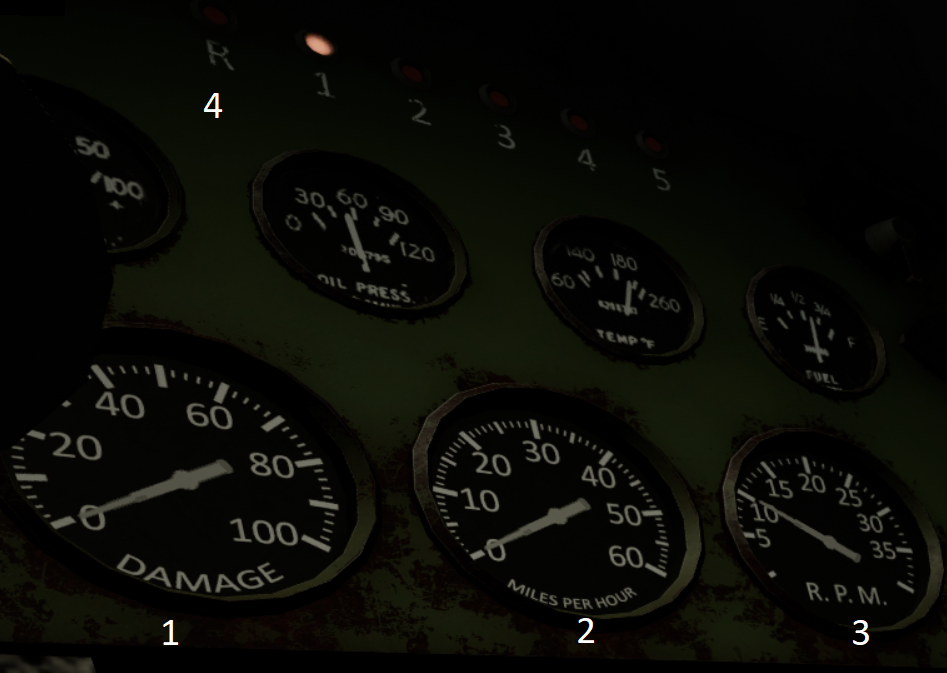
The dashboard in the Firefly is on the left side of the cockpit. The T-34’s dashboard is similar except the gear reminder and damage indicator is in front. The instruments are:
1. Damage Indicator 2. Speedometer 3. Tachometer 4. Gear Reminder. Not pictured: Compass (Right side of the driver).
Most of the instruments are self-explanatory: the damage tells you when you blow up, the speedometer tells you how fast you’re going, the gear reminder lets you know what gear you’re in, and the compass tells you your bearing. The one instrument we want to focus on is the tachometer.
The tachometer is our engine speed monitor. It tells us if the engine is about to stall or blow up and when to shift up or down. I would say worry less about your speed (since you’re not going to get pulled over by cops) and focus on keeping the engine happy.
Thankfully reading and using the tachometer is quite easy. The gauge measures the rotations per minute (RPM) multiplied by (I’m assuming) 100. With that, it seems like the limits of the Firefly engine are between 500-4000 RPM. With it idling around 1000 RPM, I would suggest not dipping below 1500 and exceeding 3300 for starters. The tachometer of the T-34 indicates a lower revving engine from 400 to 3000 RPM with an idle of 450. I would recommend staying somewhere around 1400 to 2500 RPM and shifting once you’re out of that range.
Again, from “The Manual Transmission” section, low RPMs won’t provide enough torque to accelerate the tank, and going above the limits of the engine (in real life) would damage it (while also not providing efficient acceleration). Engines perform optimally within a band of the tachometer. I don’t know to find this band for optimal shifting but in general, keep the RPMs higher when you need to accelerate quickly and keep RPMs lower for less noise, engine braking, gas wastage.
Remember that ground speed, engine speed, and selected gear are all connected. Over time, you will learn which gear you need for what case, for what speed, and what RPM you’ll be at.
The takeaway: if you’re stepping on it and you’re not moving, look at your tachometer and gear selection (you probably need to shift down). If you’re stepping on it, and you’re not going any faster even though the engine is on full blast, you probably need to shift up.
Gear Stick Patterns
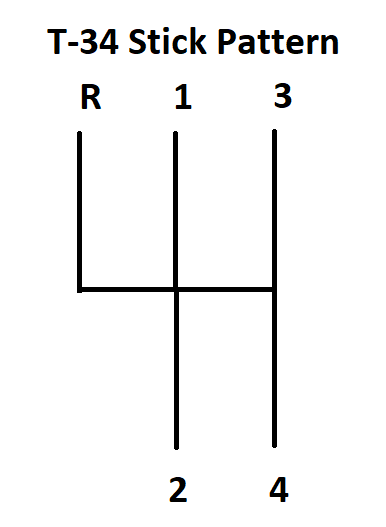
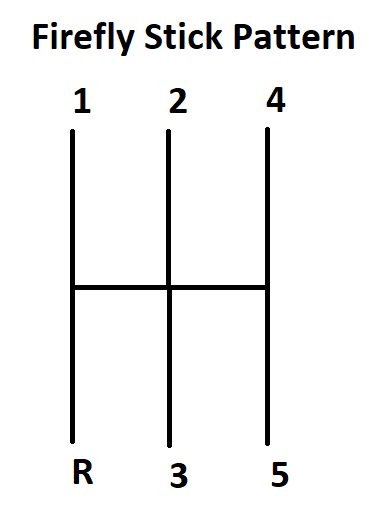
The Firefly has 5 forward gears and the T-34 has 4. Their reverse placements are slightly different. Keep practicing shifting and you’ll be mowing through them in no time. It’s not the end of the world if you forget which gear you’re in, all you need to know is if you need to shift up or down. Remember to look at the tachometer if you’re unsure about your selection! If you’re not in a gear, you’re in neutral (you’ll just be coasting since the engine isn’t gonna power anything).
In Practice
Now that we’ve covered the basics, time to put it all together. In this section, I’ll give you the straight-up checklist on how to get going in any situation. For any explanations refer to the sections above or tips below. For controls, check it out in the game. In general, WASD to move and QE to shift. For VR, right trigger is for accelerating. Use your hands with the bumper to interact with everything else. Don’t forget to open the hatch for better visibility.
1. Select first gear.
2. Hold down accelerate
3. Watch tachometer. (1st gear is super tall so it will max out almost instantly).
4. Let go of the accelerator and immediately shift to a higher gear when the engine exits the power band (2.5k T-34, 3k Firefly).
5. Accelerate
6. Repeat 3-5 until the desired speed is reached. Then shift into the highest gear appropriate for cruising.
One of the disadvantages of clutch braking is its limited ability to turn in place. In this game, fully engage the lever in the direction you want to turn in and accelerate in the first gear. You might turn faster if you’re already in motion.
I’ve seen that if you grab both levers while in gear, you can start to roll. By default, it seems like the tank uses a parking brake when stopped, and grabbing the levers disengages it. If you are in motion, and not in a gear, it is possible to skip first as that gear is usually for taking off and hills. Always check your tachometer.
- To lean in a direction (<30 degrees), pull on the corresponding lever slightly while in motion (less than 20% of the full swing). Adjust the pressure accordingly while keeping the accelerator held. By ensuring that you do not engage the brakes, little speed will be lost.
- To turn in a direction (30-60 degrees), you’ll have to engage the appropriate lever up to halfway towards you. Try to keep the accelerator engaged unless you’re coming in too hot. Keep an eye on your tachometer as you come out of the turn. You might’ve lost enough speed to downshift.
- To hard turn (60-90 degrees), release the accelerator, pull the lever up to 75% of the way towards you, expect a great loss of speed. You should expect to downshift once and maybe twice before you come out.
- To spin (90-180 degrees), disengage throttle, pull the appropriate lever up to 100% towards you. Expect the tank to slide and shift into first or second. You’ll be starting from a stop or a roll.
There are two ways to slow down. You can use your engine, your brakes, or both.
To use your engine, let go of the accelerator and downshift so you are always at the upper revolution limits (look at your tachometer). As the engine puts up resistance and slows the tank down, downshift to keep the revolutions high. The advantage of this is that you’re always in the appropriate gear so you can take off faster. The disadvantage is that you might damage the engine (in real life).
You can use your brakes to slow down or stop. Pull both levers back towards you appropriately. Make sure you are in the correct gear before taking off again.
Tips and References
Finally, I will put in a few more suggestions to make your drive enjoyable. This list will be updated as I come up with more or if the game gets updated.
Know how your tank will be affected by the terrain and anticipate gear changes. For example, if a steep hill is coming up, you know that tank will be slowing down. As soon as you hit the base of that hill, expect your speed and RPM to go down, and downshift accordingly.
If you’re driving downhill, there will be less resistance and your tank will pick up speed faster. Expect shorter times between shifts.
This turning system is straightforward; you slow down to turn. This simplicity comes with disadvantages that you should be aware of. Because turning involves braking, turning in place is slow and limited. It involves dragging one track while the other churns through the dirt. You might have more luck picking up some speed. Also turning while going uphill might result in a massive loss of power and speed.
Getting used to the tank takes time. Soon, you will have the gearboxes memorized. You can tell if you’ve shifted wrong just by listening to the sound of the engine. You might even know what RPM you’ll be at in any given gear and speed. You might still have to glance over at the gear selector though since you can’t feel the notches and glance at the tachometer since you can’t feel the resistance of the engine. The better you get at driving, the more you can focus on staying alive.
Although this guide was purely about driving the tank, driving isn’t your only job. You are in danger of dying at any given moment. This goes hand in hand with becoming proficient. Eventually, you don’t want driving to be a distraction. Help out your commander with spotting. Know the dimensions of the tank. Can you fit in that alley? Where is the turret? Will it get snagged on a tree as I turn? Do I have enough torque to make it up this hill? Is my barrel going to hit the ground as I finish descending this hill? How can position my tank in the best way possible against this tank?
Remember your role and keep in mind that it’s a multi-crewed vehicle, not your car. You and your team must work together to survive. You usually do not have all the information needed to make a good decision so communicate! Can the gunner even depress/elevate the gun to the target you’re looking at? You may be facing the tank towards a threat you see off in the distance but does the commander want you to turn and face the tank right behind you?
